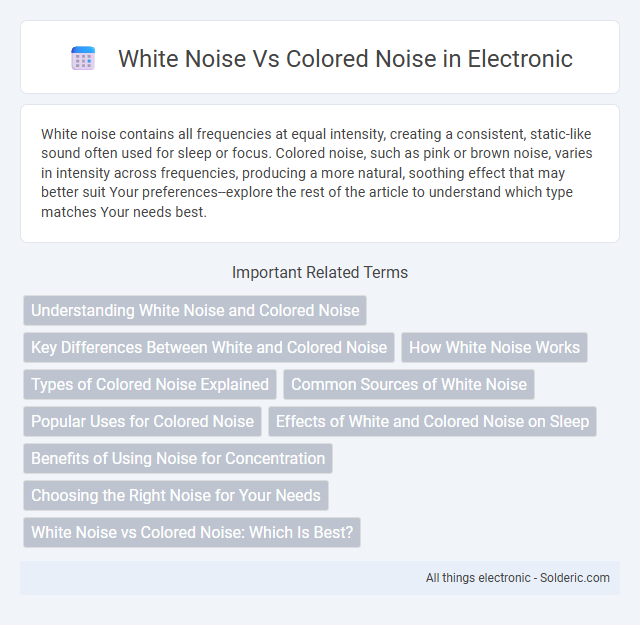White noise contains all frequencies at equal intensity, creating a consistent, static-like sound often used for sleep or focus. Colored noise, such as pink or brown noise, varies in intensity across frequencies, producing a more natural, soothing effect that may better suit Your preferences--explore the rest of the article to understand which type matches Your needs best.
Comparison Table
| Feature | White Noise | Colored Noise |
|---|---|---|
| Spectrum | Equal intensity across all frequencies | Varies by type (e.g., pink noise decreases with frequency) |
| Types | Single type (flat spectrum) | Multiple types (pink, brown, blue, violet) |
| Sound Characteristics | Hissing sound, harsh and uniform | Smoother or harsher depending on color, less uniform |
| Applications | Audio testing, masking, sleep aid | Audio engineering, sound therapy, environmental noise modeling |
| Power Spectral Density (PSD) | Constant PSD | PSD varies inversely with frequency according to type |
Understanding White Noise and Colored Noise
White noise consists of equal intensity across all frequencies, creating a constant, unvarying sound often used for sound masking and sleep improvement. Colored noise, such as pink or brown noise, varies in intensity across frequencies, emphasizing lower frequencies for a more soothing effect tailored to your auditory preferences. Understanding these differences helps you choose the right noise type for relaxation, concentration, or masking unwanted sounds.
Key Differences Between White and Colored Noise
White noise contains all audible frequencies at equal intensity, producing a consistent, unvarying sound spectrum, whereas colored noise features frequency components with varying intensities, creating distinct spectral patterns such as pink, brown, or blue noise. Pink noise has equal energy per octave, resulting in a balanced, natural sound, while brown noise emphasizes lower frequencies, generating deeper, rumbling tones. These spectral differences influence their applications in audio testing, sound masking, and therapeutic environments.
How White Noise Works
White noise works by producing a consistent sound that contains all audible frequencies at equal intensity, masking background noises and improving focus or sleep quality. This uniform distribution of sound frequencies creates a calming environment by reducing sudden changes in sound, which can disrupt concentration or rest. Your brain perceives white noise as a steady, unobtrusive sound that helps drown out distractions efficiently.
Types of Colored Noise Explained
Colored noise encompasses various types distinguished by their spectral density characteristics, including pink noise with equal energy per octave, brown noise featuring energy decreasing by 6 dB per octave, and blue noise exhibiting energy increasing by 3 dB per octave. Each type serves distinct applications in audio testing, sound masking, and therapeutic environments due to their frequency distribution. Understanding the specific power spectrum of each colored noise type enables more effective utilization in acoustics, electronics, and signal processing domains.
Common Sources of White Noise
Common sources of white noise include electronic devices such as fans, air conditioners, and computer hard drives, which generate a broad spectrum of frequencies at equal intensity. White noise is characterized by its constant energy distribution across all audible frequencies, resulting in a consistent, static-like sound used in masking unwanted environmental sounds. This contrasts with colored noise types like pink or brown noise, which have frequency-dependent intensities, making white noise ideal for applications in sound masking and audio testing.
Popular Uses for Colored Noise
Colored noise, such as pink, brown, and blue noise, is widely used in audio testing, sound masking, and sleep therapy due to its frequency-dependent energy distribution that mimics natural soundscapes. Pink noise, with equal power per octave, is popular for promoting relaxation and improving sleep quality, while brown noise's deeper tones help in concentration and reducing tinnitus symptoms. Your choice of colored noise can enhance specific auditory experiences by aligning with the desired environmental or therapeutic effect.
Effects of White and Colored Noise on Sleep
White noise produces a consistent, unvarying sound that can mask disruptive environmental noises and promote faster sleep onset by creating a stable auditory environment. Colored noise, such as pink or brown noise, offers a frequency spectrum that more closely resembles natural sounds, often enhancing sleep quality by reducing brainwave variability and promoting deeper rest. Understanding these effects allows you to choose the optimal noise type to improve your sleep hygiene and overall restfulness.
Benefits of Using Noise for Concentration
White noise and colored noise both mask distracting sounds, enhancing focus by creating a consistent auditory environment that reduces cognitive interruptions. You can improve productivity and concentration in noisy settings by using these types of noise, as they help filter out background disturbances and promote mental clarity. Studies show that personalized noise selection, whether white or colored, can optimize alertness and support sustained attention during tasks.
Choosing the Right Noise for Your Needs
White noise contains equal intensity across all frequencies, making it ideal for masking background sounds and aiding concentration or sleep. Colored noise, such as pink or brown noise, emphasizes specific frequency bands and is preferred for applications requiring more natural or soothing auditory experiences. Selecting the right noise depends on individual sensitivity, purpose, and environmental factors to maximize effectiveness in sound masking or relaxation.
White Noise vs Colored Noise: Which Is Best?
White noise contains all frequencies at equal intensity, making it ideal for masking background sounds and improving concentration or sleep quality. Colored noise, such as pink or brown noise, emphasizes specific frequency ranges to create a smoother, more natural sound preferred for relaxation or audio testing. Choosing between white noise and colored noise depends on whether the goal is sound masking efficiency or a more soothing auditory experience.
White noise vs colored noise Infographic

 solderic.com
solderic.com